The Crusades were a series of wars carried out by the Catholic Church between the years 1096 and 1272 and whose stated objective was to reconquest of the Holy Land - Jerusalem.
Over 200 years, 9 official and 2 unofficial Crusades were carried out. The crusades were violent wars, they caused many deaths and, considering their main objective, they were a failure.
The Crusades, also called Saint war, received this name because the crusaders used a cross - a symbol of Christianity - stamped on their clothing during battles.
Despite the stated motivation to reconquer Jerusalem, the Crusades also had other motivations, such as territorial conquests, search for riches and new trade routes.
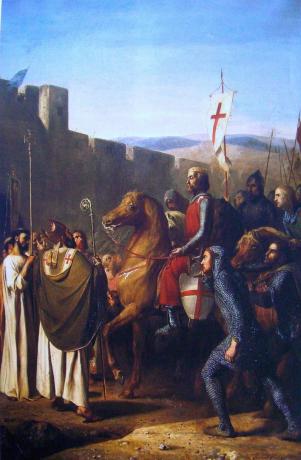 Baudouin I of Jerusalem, one of the leaders of the First Crusade.
Baudouin I of Jerusalem, one of the leaders of the First Crusade.
The beginning of the Crusades
To understand the context in which the Crusades began, it is important to understand the relevance of Jerusalem to Christianity. In Jerusalem is the holy sepulcher, place where Jesus Christ was buried.
But Jerusalem it's also a local
sacred for Muslims and Jews, and for that reason it has been a subject of dispute for centuries.The city had been under Arab rule since 638, but Christians managed to visit it. From 1071, with the conquest of the territory by the Seljuk Turks, the Christian pilgrimage to the place became difficult.
Pope Urban II then called the faithful to participate in these expeditions to recover Jerusalem. In exchange, the crusaders - the name given to those who participated in the crusades - would have the remission of their sins.
It is known, however, that the Crusades had different motivations besides the reconquest of the Holy Land. Some of these motivations were religious, others commercial and territorial.
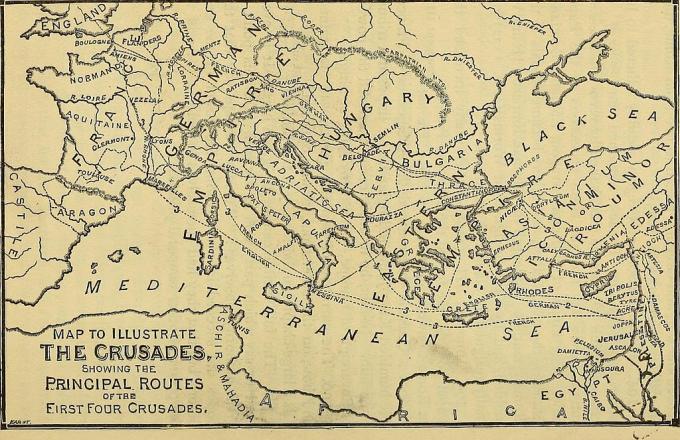 Map of the routes of the first four Crusades.
Map of the routes of the first four Crusades.
Learn more about christianity, O Judaism it's the Islam.
Crusade Objectives
recapture Jerusalem
Catholics were interested in regaining control of the city of Jerusalem, which had been conquered by Muslims centuries ago. This was a motivation that united both Christians in the Catholic Church and Christians in the Orthodox Church.
Learn more about Catholic church and the orthodox church.
Stop the advance of Islam and protect the Byzantine Empire
In the 11th century, Muslims began to expand and conquer new territories. Muslims had already conquered the Iberian Peninsula and threatened to invade the Byzantine Empire, which was dominated by the Orthodox Church.
Rapprochement between Catholic Church and Orthodox Church
In 1054 there was a break in the Christian Church between the Roman Catholic Church and the Orthodox Church, an episode that became known as the Great Schism. With the threats of Islam, the Catholic Church sought to get closer to strengthen itself.
Conquest of territories and new trade routes
Due to population growth in Europe, many nobles participated in the Crusades to conquer lands in the east. There was also a desire to resume trade routes across the Mediterranean, which had been disrupted by the fall of the Roman Empire.
Understand how the fall of the Roman Empire.
Reconquest of the Iberian Peninsula
The Iberian Peninsula, where Portugal and Spain are now located, had been dominated by Muslims and Christians wanted to recover this territory.
Crusade Summary
Over these two centuries, there were 9 official crusades and two unofficial crusades. See the summary about each of them:
Beggars Crusade (1096) - Unofficial
This Crusade was a popular movement called upon by the monk Peter, the hermit. The monk managed to bring together many people, including children, women, the elderly and beggars.
As they lacked resources, the Crusaders began to rob the infidels. On these occasions they killed a very large number of Jews, causing great revolt.
When they arrived in Constantinople, capital of the Byzantine Empire, which was on its way to Jerusalem, the Crusaders were already weakened. They were welcomed by the Emperor, but were soon expelled as they sacked the city.
Learn more about the holy city of Jerusalem.
First Crusade (1096 - 1099)
Also called Knights Crusade, this was the first official Crusade, called by Pope Urban II.
This was the only successful crusade considering the objective of reconquering the Holy Land. During this conflict, there were many deaths, mainly of Turks in Jerusalem.
Thousands of Crusaders also died along the way due to the hunger, thirst and disease that spread among the combatants.
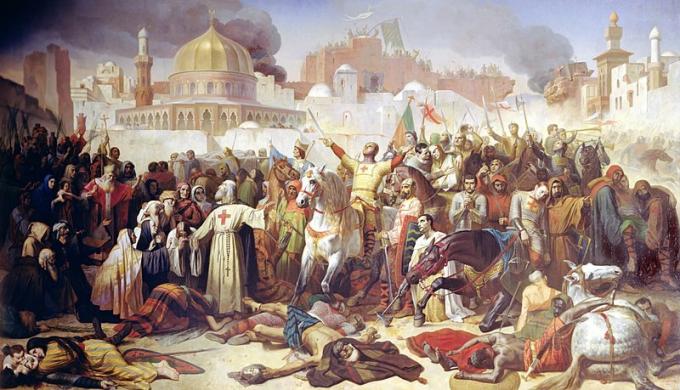 Takeover of Jerusalem by the Crusaders in 1099.
Takeover of Jerusalem by the Crusaders in 1099.
Second Crusade (1147 - 1149)
The Crusaders aimed to attack Damascus, but they were defeated by the Turks. This crusade was a failure, except for the fact that they managed to regain Lisbon.
Third Crusade (1189 - 1192)
This Crusade was called Kings Crusade, as it was led by King Frederick I of Germany, King Philip II of France and King Richard the Lion of England.
By 1189 the Arabs had regained control of Jerusalem, but the Crusaders managed to negotiate with Arab Sultan Saladin to open Jerusalem for Christian pilgrimage.
Fourth Crusade (1202 - 1204)
At that time, resources for the Crusades were exhausted. The Duke of Venice then offered to finance the Crusaders on condition that they would help him regain the city of Zara.
On the way to Jerusalem, the Crusaders arrived in Constantinople and completely sacked the city. The amount of money and valuables stolen was so great that the Crusaders gave up on going to Jerusalem and went back to Europe.
This episode had an extremely negative repercussion, as the Byzantines (Orthodox) were a friendly nation of the Catholic Church. After this crusade, the rift between the Christian churches only intensified.
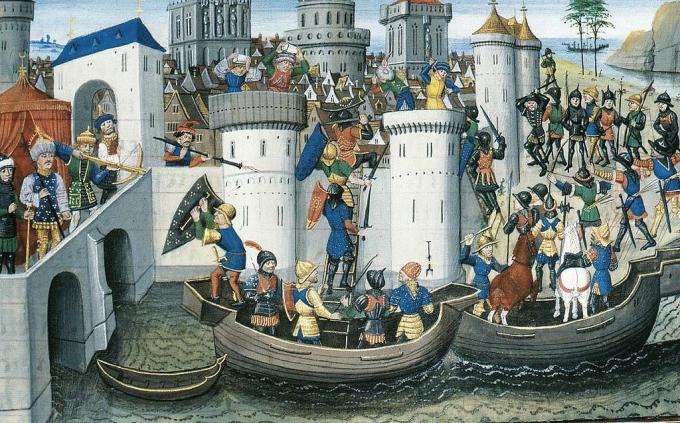 Conquest of Constantinople by the Crusaders in 1204.
Conquest of Constantinople by the Crusaders in 1204.
Children's Crusade (1212) - unofficial
The Children's Crusade came about as a result of the Fourth Crusade. The looting and destruction of the city of Constantinople came as a shock to the Byzantines and people began to believe that only pure people they could regain the Holy Land.
About 50,000 children were put on ships and sent to Jerusalem. Many of these children died of cold, hunger and disease or were sold into slavery.
It is not clear what actually happened in this crusade and what is fantasy.
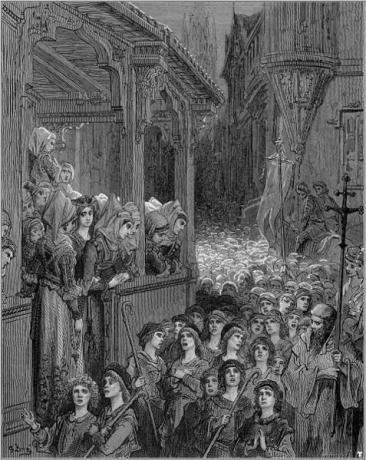 Children's Crusade.
Children's Crusade.
Fifth Crusade (1217 - 1221)
In the Fifth Crusade, the Crusaders decided that they would first conquer Egypt and then head towards Jerusalem. The Sultan of Egypt offered Jerusalem to the Crusaders to avoid war, but they would not accept.
While waiting for reinforcements to continue the battle for Egypt, the Crusaders were defeated and had to return to Europe.
Sixth Crusade (1228 - 1229)
The sixth Crusade was the only peaceful crusade. Emperor Frederick II of Germany, who led this Crusade, managed to negotiate the possession of Bethlehem, Nazareth and Jerusalem for 10 years.
Seventh Crusade (1248 - 1254)
In this Crusade, Christians again tried to invade Egypt before reaching Jerusalem. The Egyptians again offered Jerusalem to the Crusaders, who again did not accept.
The Crusaders were not only defeated by the Egyptians, they had their leader and king of France, Louis IX, captured. To release him, they had to pay an extremely high price to the sultan.
Eighth Crusade (1270)
Louis IX, dissatisfied with the defeats in Egypt, decides to return to the country, now with the objective of Christianizing the Egyptian sultan. Arriving in the country, Louis IX catches a disease and dies.
Ninth Crusade (1271 - 1272)
The Ninth Crusade was led by Prince Edward I of England. But arriving in Jerusalem, the prince learned of his father's death and had to return to his country.
The Crusades took place during the Middle Ages, learn more about that time.
Consequences of the Crusades
The wars over these 200 years have not achieved the goal of re-conquering Jerusalem, but they have had many social, economic, religious and political consequences. See some of them:
- Opening of trade with the Mediterranean: trade in the region had been impeded by Muslim expansion;
- Definitive break between the Catholic Church and the Orthodox Church: especially after the sacking of Constantinople in the Fourth Crusade;
- Weakening of the European nobility: many nobles lost lands and serfs during the Crusades;
- Intensifying conflicts between Christians and Muslims: fighting during the crusades increased the rivalry between these religions;
- Strengthening the bourgeoisie: with new trade routes created, the bourgeois class strengthened;
- Intensification of the crisis of feudalism: with the weakening of the nobility and the strengthening of the bourgeoisie, feudalism is on the way to its end;
- Rebirth of cities: with the strengthening of commerce and the bourgeoisie, cities begin to be reborn.
See also the meaning of feudalism, bourgeoisie and nobility.
